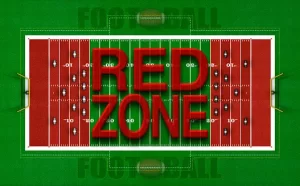The Red Zone is a critical area on a football field that has garnered much attention, analyses, and strategic adjustments from both offensive and defensive perspectives. What is the Red Zone in Football? Extending from an opponent’s 20-yard line to the goal line, the Red Zone is considered the prime location for scoring touchdowns or field goals. The Red Zone is the football field from the 20 yard line to the goal line, when on offense.
Familiarizing oneself with the significance and peculiarities surrounding the Red Zone will enhance one’s understanding of how teams maximize their chances of scoring during a game.
When an offense reaches the Red Zone, the play strategy often shifts to account for the shorter field and heightened intensity of the defense.
As the end zone is within reach, the value of each play increases, and coaches often implement unique plays and tactics designed specifically for this part of the field.
Conversely, the defense adapts their formation and approach in an attempt to stifle the offense’s momentum, limit their scoring options, and ideally force a turnover.
Contents
Red Zone Definition and Purpose
The Red Zone in football is a term used to describe the area on the field between an opponent’s 20-yard line and their goal line.
This section of the field is crucial for both the offense and defense, as it presents a high chance of scoring a touchdown.
The purpose of the Red Zone is to intensify the game’s strategy and increase the excitement for players and viewers.
When an offensive team enters the Red Zone, they are within striking distance of scoring points through a touchdown or field goal. Consequently, their play-calling often becomes more aggressive and focused on short-yardage gains through running or passing plays.
Performance in the Red Zone can be a key factor in a team’s success. Some important Red Zone performance indicators include:
- Offensive Red Zone Efficiency: The percentage of Red Zone opportunities that result in a touchdown.
- Defensive Red Zone Efficiency: The percentage of opponents’ Red Zone opportunities that are prevented from becoming a touchdown.
- Field Goals: The number of successfully completed field goal attempts from the Red Zone.
In summary, the Red Zone serves as a critical area of the football field where both the offense and defense must execute their plays with precision in order to succeed.
This heightened focus on strategy and performance creates a thrilling experience for players and fans alike.
Offensive Strategy in the Red Zone
The red zone in football refers to the last 20 yards before the end zone on a football field. When an offensive team enters the red zone, they are expected to score points, either by a touchdown or a field goal. To achieve this, offensive teams employ various strategies to overcome the defense.
Running Plays
Running plays can be beneficial in the red zone due to their ability to control the clock and wear down the defense. This can lead to opportunities to score touchdowns. Some common running plays in the red zone include:
- Power Runs: Employing extra blockers, like tight ends and fullbacks, to create running lanes for the running back.
- Inside Zone Runs: This play involves the offensive line creating gaps in the defensive line for the running back to exploit.
- Delayed Handoffs or Draws: This strategy can be useful in catching the defense off guard, as they may anticipate a passing play due to the close proximity to the end zone.
Passing Plays
Passing plays in the red zone can be challenging for offenses due to the limited field space. As a result, offenses must be creative with their play calling to exploit the compressed field. Some common red zone passing plays include:
- Slant Routes: Quick, short passes to wide receivers, who cut sharply towards the middle of the field to create separation from the defender.
- Fade Routes: These routes involve the wide receiver running towards the back corner of the end zone, with the quarterback throwing a high-arcing pass, allowing the receiver to use their height and jumping ability to catch the ball over the defender.
- Play-Action Passes: This strategy involves faking a handoff to a running back before passing, aiming to draw the defense in and creating openings for receivers to make a catch in the end zone.
By using a balanced mix of running and passing plays in the red zone, the offense aims to keep the defense guessing and ultimately, score touchdowns or set up opportunities for field goals.
Defensive Strategy in the Red Zone
Goal-Line Defense
The goal-line defense is an important aspect when it comes to stopping the opposing team from scoring in the red zone.
This defensive formation usually consists of extra defensive linemen and linebackers to help stop the run game and limit passing options.
The primary focus of the goal-line defense is to clog up the running lanes and create a wall, making it difficult for the opposing team to advance the ball into the end zone.
Preventing the Touchdown
Another critical aspect of defensive strategy in the red zone is to prevent the touchdown.
The defensive players must adjust their tactics to limit the offensive options available.
One way to do this is by employing a zone defense strategy where players are assigned specific areas to cover, ensuring that they are in position to stop both running and passing plays. This approach helps to mitigate the risk of an offensive player breaking free and scoring.
Additionally, defensive teams may opt for more conservative play calling in the red zone due to the high-stakes nature of the situation.
One wrong move can be the difference between winning and losing the game. A strong red zone defense requires a blend of effective tactics, strategic play calling, and skillful execution by all players involved.
Red Zone Statistics and Importance
Team Performance
The red zone is a critical area in football, as it refers to the offensive team’s last 20 yards before reaching the opponent’s end zone.
Due to its high chance of scoring touchdowns, it’s essential to understand how well teams perform in the red zone.
- Teams with a high red zone scoring percentage are more likely to win games as they utilize their scoring opportunities efficiently.
- Analyzing red zone performance can help identify teams with strong offensive and defensive strategies when approaching the opponent’s end zone.
Individual Player Performance
Evaluating players’ performances in the red zone is crucial in both real-life football and fantasy football.
-
Quarterbacks: Quarterbacks with high red zone completion rates and touchdown-to-interception ratios are more likely to lead their teams to victory. For fantasy football, these QBs are valuable assets as they score more points for their team.
-
Wide Receivers and Tight Ends: Players with a high number of red zone targets and receptions are more likely to score touchdowns. In fantasy football, these players have great potential to contribute to their fantasy owner’s success.
-
Running Backs: Running backs with a high number of red zone carries and touchdowns are vital in real-life football and fantasy football. With a higher chance of scoring, these players contribute significantly to their team’s success and their fantasy owner’s points.
Overall, understanding and considering red zone statistics and performance is essential when evaluating both teams and individual players’ performance in football.
Conclusion
The Red Zone in football is a critical part of the game, as it refers to the last 20 yards before the end zone on a football field. This area is crucial for both the offense and defense, as it’s where the offense has a high likelihood of scoring a touchdown while the defense aims to prevent that from happening.
Some teams excel in the Red Zone, with better statistics in terms of touchdown conversions when compared to others. For example, during the 2020-2021 season, the Green Bay Packers led the league with a touchdown scoring percentage of 76.81% when entering the Red Zone, closely followed by the Tennessee Titans with a 74.24% conversion rating.





